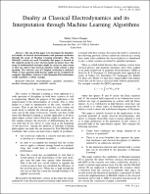| dc.contributor.author | Nieto-Chaupis, Huber | |
| dc.date.accessioned | 2023-09-21T16:29:13Z | |
| dc.date.available | 2023-09-21T16:29:13Z | |
| dc.date.issued | 2022 | |
| dc.identifier.uri | https://hdl.handle.net/20.500.13067/2614 | |
| dc.description.abstract | The aim of this paper is to investigate the hypothetical duality of classical electrodynamics and quantum mechanics
through the usage of Machine Learning principles. Thus, the Mitchell’s criteria are used. Essentially this paper is focused on the radiated energy by a free electron inside an intense laser. The usage of mathematical strategies might be correct to some extent so that one expects that classical equation would contain a dual meaning. The concrete case of Compton scattering is analyzed. While at some quantum field theories might not be scrutinized by computer algorithms, contrary to this Quantum Electrodynamics would constitute a robust example. | es_PE |
| dc.format | application/pdf | es_PE |
| dc.language.iso | eng | es_PE |
| dc.publisher | (IJACSA) International Journal of Advanced Computer Science and Applications | es_PE |
| dc.rights | info:eu-repo/semantics/openAccess | es_PE |
| dc.rights.uri | https://creativecommons.org/licenses/by/4.0/ | es_PE |
| dc.subject | Classical electrodynamics | es_PE |
| dc.subject | Quantum mechanics | es_PE |
| dc.subject | Machine learning principles | es_PE |
| dc.subject | Mitchell’s criteria | es_PE |
| dc.title | Duality at Classical Electrodynamics and its Interpretation through Machine Learning Algorithms | es_PE |
| dc.type | info:eu-repo/semantics/article | es_PE |
| dc.identifier.journal | (IJACSA) International Journal of Advanced Computer Science and Applications | es_PE |
| dc.identifier.doi | https://doi.org/10.14569/IJACSA.2022.0130877 | |
| dc.subject.ocde | https://purl.org/pe-repo/ocde/ford#2.02.04 | es_PE |
| dc.source.volume | 13 | es_PE |
| dc.source.issue | 8 | es_PE |
| dc.source.beginpage | 676 | es_PE |
| dc.source.endpage | 681 | es_PE |


